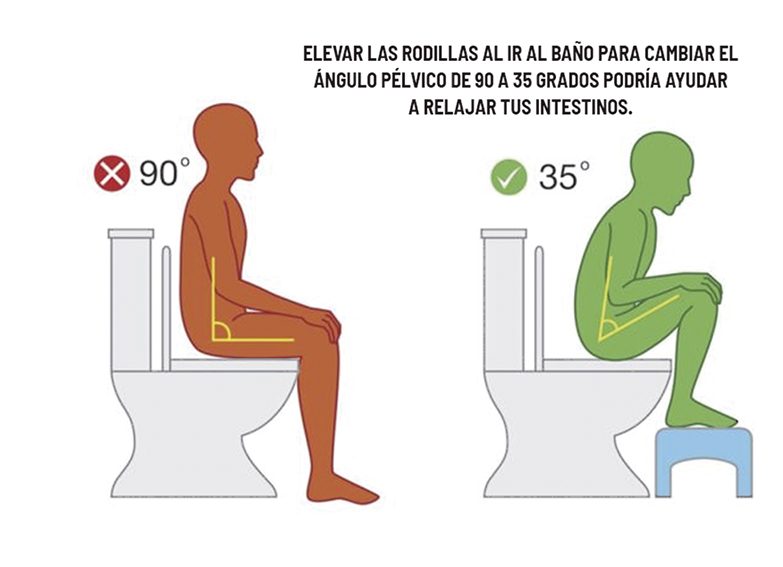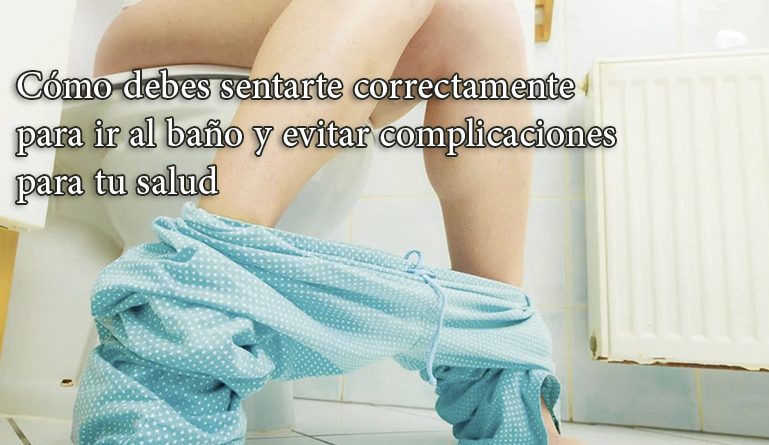How to sit properly to go to the bathroom and avoid complications for your health
Si estás sentada o sentado en el inodoro leyendo esto y estás teniendo dificultades para evacuar tal vez sería recomendable que consideres si la posición que has adoptado es la mejor para ir al baño.
¿Cómo? te preguntarás. ¿Hay algo que pueda superar la comodidad de un baño moderno?
Este no es un asunto trivial. Una persona promedio invierte seis meses de su vida sentada en el inodoro o retrete.
En ese proceso produce 145 kilos de materia fecal al año. Más o menos lo que pesa un gorila adulto.
Teniendo en cuenta la relevancia de esto en nuestras vidas, vale la pena evaluar si la posición que adoptamos al ir al baño es la correcta.
¿Cuánto tiempo gastas yendo al baño?
A mediados del siglo XX, un grupo de médicos europeos que trabajaban en zonas rurales de África quedaron sorprendidos ante la baja incidencia de problemas intestinales y digestivos entre la población local.
Esa tendencia se pudo constatar en varios otros países en desarrollo a través del mundo.
El fenómeno no se debía solamente a la dieta. Tenía que ver con el tiempo en que pasaban evacuando los intestinos y la posición que adoptaban al hacerlo.
El tiempo promedio que una persona de Occidente pasa cada vez que se sienta en el inodoro para realizar esta actividad vital es entre 114 y 130 segundos.
Resulta que, en varios países en desarrollo, hace sus necesidades en el campo, la calle, o en baños rudimentarios donde no hay inodoros de asiento como los conocemos, sino básicamente huecos en el suelo que obligan a la persona a aculillarse.
Parecerá indecoroso, pero los que adoptan una posición en cuclillas gastan sólo 51 segundos yendo al baño y eso, señalan los expertos, es más saludable.
Lo que sucede es que la posición sentada en el retrete coloca nuestro canal anal a un ángulo de 90 grados.
Eso hace que un músculo en el suelo pélvico constriña el colon, lo que nos obliga a esforzarnos para evacuar.
¿Por qué seguimos usando inodoros de asiento en muchas partes del mundo?
Se estima que los primeros retretes básicos se remontan a unos 6.000 años, en la antigua Mesopotamia.
Para el año 315 d. C., en Roma había 144 escusados públicos e ir al baño se había convertido en un evento social.
Un baño público de 2.000 años de antigüedad, excavado en el monte Palatino en Roma, estaba compuesto de más 50 huecos, uno al lado del otro. Eso sí es estar en íntima compañía.
La creencia popular es que Thomas Crapper, un plomero inglés, fue el inventor del retrete clásico de asiento. Sin embargo, su diseño apenas fue patentado en 1861.
En realidad, el primer retrete con descarga fue inventado en 1592 por John Harrington, un cortesano isabelino, que llamó su creación el Ajax.
Lo que Crapper sí desarrolló fue la tubería en U, que creaba un tapón de agua para evitar el regreso de gases y olores producidos por el desperdicio.
Ese invento fue lo que hizo que los retretes fueran construidos elevados del piso porque facilitaba su instalación.
Ese modelo de retrete de asiento ha llegado a ser considerado como un gran logro y señal de la “civilización” en Occidente.
Los riesgos a la salud
Todos hemos pasado por la angustia de apretar los dientes y empujar hasta que se nos hinchan las venas y el corazón se acelera.
Eso puede deberse al estreñimiento. mala digestión y otros problemas intestinales.
Pero muchos expertos culpan la posición sentada que hay que asumir en los retretes de asiento convencionales.
Esa ha sido vinculada a los problemas de hemorroides, desmayos e, inclusive, derrames cerebrales.
A mediados de los 1960, el profesor Alexander Kira, de la Universidad de Cornell, describió el retrete de asiento como “el más inadecuado elemento jamás diseñado”.
El médico personal de Elvis Presley especuló que el ataque cardíaco que mató al rey del Rock fue causado por el esfuerzo que hizo yendo al baño.
Sencilla solución
No se trata ahora de deshacernos de los inodoros que tenemos instalados en casa y acuclillarnos en un hueco en el baño.
Hay una opción más sencilla.
Elevar las rodillas al ir al baño para cambiar el ángulo pélvico de 90 a 35 grados podría ayudar a relajar tus intestinos.
Eso reduciría el constreñimiento en la curva donde el colon se une con el recto.
Eso lo podrías lograr fácilmente colocando tus pies sobre un taburete o, si no lo tienes y es una emergencia, usando un par de directorios telefónicos.
Así que no los tires a la basura. Esos gruesos libros todavía tienen uso práctico después de todo.

ENGLISH
If you are sitting or sitting in the bathroom reading this and you find it difficult to evacuate, it is advisable to consider if the position you have taken is the best one to go to the bathroom.
How? you wonder Is there anything that can overcome the convenience of a modern bathroom?
This is not a trivial matter. An average person spends six months of his or her life sitting in the bathroom or bathroom. An adult gorilla weighs more or less.
Because of its relevance to our lives, it is important to evaluate the position we hold when going to the bathroom.
In the mid-twentieth century, a group of European doctors working in rural Africa were alarmed by the low incidence of intestinal and digestive problems in local populations.
This trend can be seen in many other developing countries around the world.
The phenomenon is not just because of diet. It has to do with the time they spend leaving the bowels and the position they take in doing so.
In Africa, defendants usually force the person to be released.
The average time that a person from the West happens every time you sit in the bathroom to perform this essential activity is between 114 and 130 seconds.
It turns out that, in many developing countries, it is making demands on farms, streets, or in unsatisfactory bathrooms where there are no Chairs available as we know them, but really hollows on the ground forcing the person to squat.
This may not seem right, but those who adapt to a squatting position spend just 51 seconds going to the bathroom and, according to experts, healthier.
What happens is that the sitting position in the bathroom puts our anal canal at an angle of 90 degrees.
That produces a pelvic floor muscle constrict the colon, which forces us to keep trying to evacuate.
The seating position forces the colon and forces us to try to escape.
It is estimated that the first major bathrooms lasted about 6,000 years, in ancient Mesopotamia.
315 d. C., in Rome there are 144 public restrooms and going to the bathroom has become a social event.
In ancient Rome, going to the bathroom was a social event.
A 2,000-year-old public restroom, excavated on Palatine Hill in Rome, consists of with 50 holes, side by side . That is to be in good company.
However, its design was slightly patented in 1861.
In fact, the first toilet with its release was invented in 1592 by John Harrington, an Elizabethan courtier, calling his creation Ajax.
Crapper manufactured the U-pipe, which created a water plug to prevent the return of gases and odors caused by waste.
Crapper’s design, along with the U-pipe, forced the bathrooms to be raised in the form of a chair.
That invention made the bathrooms built from the ground up because of its easy installation.
The toilet seat model was considered a great success and a sign of “civilization” in the West.
We all passed through the anguish of clenching our teeth and pushing until our nerves became inflamed and our hearts swelled.
That may be due to constipation of poor digestion and other bowel problems.
But many experts have blamed the seating position that should have been assumed on conventional bathroom chairs.
It has been linked to problems with hemorrhoids, fatigue and even stroke. In the mid-1960s, Professor Alexander Kira of Cornell University described the chair as ” the most inappropriate element ever designed “.
Elvis Presley’s personal physician speculates that the heart attack that killed King of Rock was caused by the effort he made in the bathroom.
This is not about leaving the toilets we have installed at home and squatting in a hole in the bathroom.
The recommended position
That would reduce the compression curve where the colon joined the rectum.
You can easily achieve that by putting your feet on a stool or, if you don’t have it and it’s an emergency, using a couple of directories on the phone. So don’t throw them away. Those thick books still have practical use after all.


 (1) (2).jpg)


Debe estar conectado para enviar un comentario.